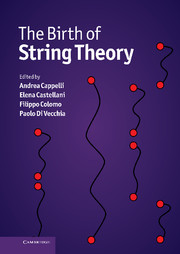Book contents
- Frontmatter
- Contents
- List of contributors
- Photographs of contributors
- Preface
- Abbreviations and acronyms
- Part I Overview
- EARLY STRING THEORY
- Part II The prehistory: the analytic S-matrix
- Part III The Dual Resonance Model
- Part IV The string
- TOWARDS MODERN STRING THEORY
- Part V Beyond the bosonic string
- 27 Introduction to Part V
- 28 From dual fermion to superstring
- 29 Dual model with fermions: memoirs of an early string theorist
- 30 Personal recollections
- 31 Aspects of fermionic dual models
- 32 The dual quark models
- 33 Remembering the dawn of relativistic strings
- 34 Early string theory in Cambridge: personal recollections
- Part VI The superstring
- Part VII Preparing the string renaissance
- Appendix A Theoretical tools of the Sixties
- Appendix B The Veneziano amplitude
- Appendix C From the string action to the Dual Resonance Model
- Appendix D World-sheet and target-space supersymmetry
- Appendix E The field theory limit
- Index
28 - From dual fermion to superstring
from Part V - Beyond the bosonic string
Published online by Cambridge University Press: 05 May 2012
- Frontmatter
- Contents
- List of contributors
- Photographs of contributors
- Preface
- Abbreviations and acronyms
- Part I Overview
- EARLY STRING THEORY
- Part II The prehistory: the analytic S-matrix
- Part III The Dual Resonance Model
- Part IV The string
- TOWARDS MODERN STRING THEORY
- Part V Beyond the bosonic string
- 27 Introduction to Part V
- 28 From dual fermion to superstring
- 29 Dual model with fermions: memoirs of an early string theorist
- 30 Personal recollections
- 31 Aspects of fermionic dual models
- 32 The dual quark models
- 33 Remembering the dawn of relativistic strings
- 34 Early string theory in Cambridge: personal recollections
- Part VI The superstring
- Part VII Preparing the string renaissance
- Appendix A Theoretical tools of the Sixties
- Appendix B The Veneziano amplitude
- Appendix C From the string action to the Dual Resonance Model
- Appendix D World-sheet and target-space supersymmetry
- Appendix E The field theory limit
- Index
Summary
I was privileged to be either a participant or an observer in many of the developments involved in string and superstring theory and my attachment to the CERN Theory Division during much of the Seventies gave me a grandstand view of much of it. In what follows I shall try to describe my own experiences, what I did, or tried to do, and what I saw and heard, because those are the things of which I am most certain. So, in particular, this does not aspire to be a comprehensive history.
I was present in the ballroom of the Hofburg when Gabriele Veneziano first presented his dual scattering amplitude to the wider world of theoretical physics during the Vienna Conference on High Energy Physics (28 August–5 September 1968). Despite the bad acoustics of the venue that experience changed my life and makes an appropriate start for my account [CERN68, Ven68], even though there is important prehistory.
The idea that there could be formulae for particle scattering amplitudes that could be, in some sense, almost exact fell on fertile ground. My scientific outlook had been formed in DAMTP, Cambridge, UK where the influence of the then charismatic figure, Geoffrey Chew, of the University of California at Berkeley still held sway. He and his school, influenced by the earlier work of Werner Heisenberg, had argued that scattering amplitudes of hadrons were the appropriate quantities to think about, rather than the quantum fields that create the particles.
Information
- Type
- Chapter
- Information
- The Birth of String Theory , pp. 346 - 360Publisher: Cambridge University PressPrint publication year: 2012
Accessibility standard: Unknown
- 7
- Cited by
